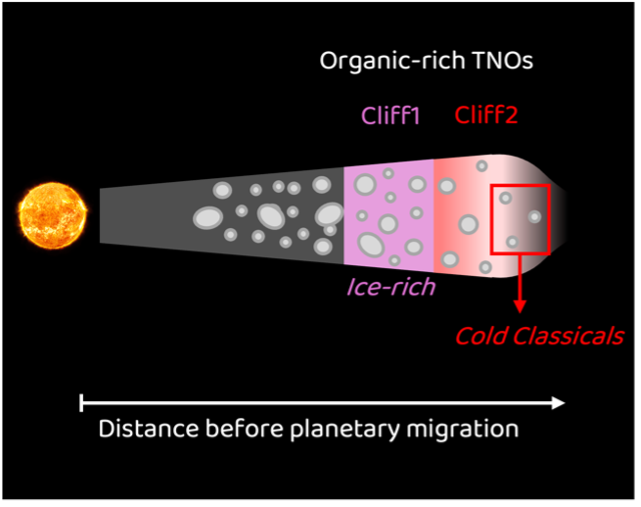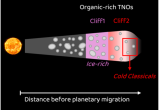JWST Reveals Early Sculpting and Late Evolution of Trans-Neptunian Objects
The James Webb Space Telescope (JWST) is transforming our understanding of trans-Neptunian objects (TNOs), the icy remnants of planetary formation. As part of the DiSCo-TNOs project, researchers have used JWST’s near-infrared data to identify two distinct groups among spectrally red TNOs, believed to be rich in organics. The key difference between these groups is the presence of surface ices—particularly methanol (CH₃OH) ice.
Methanol ice forms on dust grains in cold interstellar clouds and contributes to prebiotic chemistry. In the Solar System, it has been detected in comets and on some icy bodies, including Arrokoth, a small TNO visited by NASA’s New Horizons probe. Its presence has been debated as either a primordial feature or a result of later evolution.
JWST’s findings show that one group of TNOs, called Cliff1, has strong spectral signatures of methanol, water (H₂O), carbon dioxide (CO₂), carbon monoxide (CO), and complex organics. This suggests they formed at or beyond the methanol ice line in the protoplanetary disk, providing a rare glimpse into early disk chemistry. Over time, cosmic irradiation likely altered their surfaces, gradually depleting methanol at the surface and creating a layered structure with increasing methanol abundance at depth.
The second group, Cliff2, has weaker spectral features than Cliff1, indicating a different evolutionary path. Among them, Cold Classical TNOs— formed and remained in the outermost disk —stand out as a distinct population.
The discovery of these spectral sub-groups reveals that TNOs did not all form from the same molecular ingredients. Instead, their compositions reflect both their “heritage” (where and how they formed) and their “nurture” (the processes that shaped them). These findings also provide a critical framework for interpreting JWST’s observations of other bodies—such as Neptune Trojans, Centaurs, and asteroids—as well as for future missions exploring the outer Solar System.

A sketch of the formation regions of the two TNO groups before planetary migrations
reshuffled them. Cliff1 surfaces are ice-rich. Cliff2 includes Cold Classical TNOs,
which formed in place and remained largely undisturbed by Neptune’s migration.
Credit: Sasha Cryan, IAS, CNRS, Université Paris-Saclay.
IAS Contacts :
- Rosario Brunetto, CNRS, IAS / OSUPS rosario.brunetto @ universite-paris-saclay.fr
- Sasha Cryan, Université Paris-Saclay, IAS / OSUPS sasha.cryan @ universite-paris-saclay.fr
Online publication link (Brunetto et al., 2025, ApJL) : https://doi.org/10.3847/2041-8213/adb977




